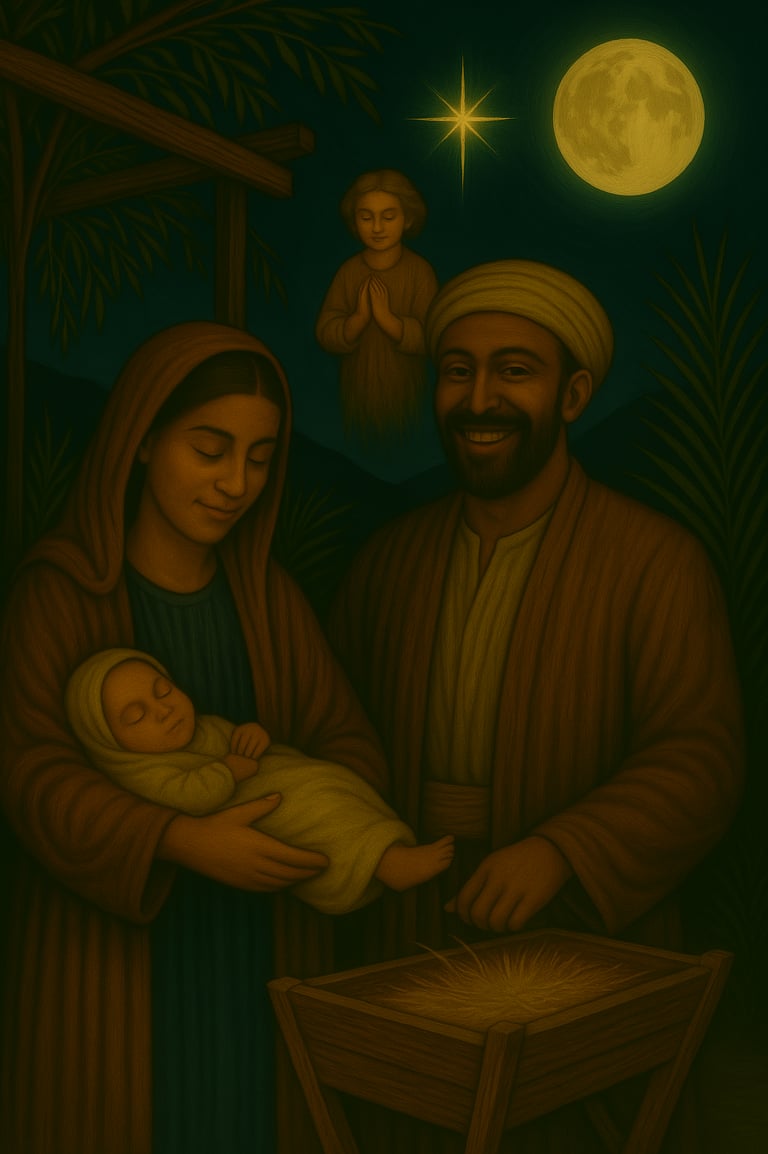Announcing that the great day of the lord is nearer than you think. O Come let us adore him - Luke 2:13
Understanding God's Calendar with Tishrei15
At Tishrei15, we explore God's nature through His biblical calendar, guiding you to recognize His divine appointments and their significance in your spiritual journey month by month.
The largest birthday celebration ever.
For those who say that Jews do not honor birthdays - https://www.chabad.org/library/article_cdo/aid/458473/jewish/Birthday.htm It is obvious that the lack of birthday references in Scripture would emphasize the one unique birthday honoured from Heaven, just not by His people. The honouring of a Jewish identity superseding Luke 2:10-14 is not the message that was delivered to us. Luke 2:17 falls on deaf ears in many Messianic Communities.
The Biblical Calendar does not begin with rabbinic conjecture or Gregorian reform. It begins with founding statements—not suggestions—in Beresheit, Genesis 1:14–16. There, the Creator speaks not in metaphor but in mechanism:
“Let there be lights in the firmament of the heaven to divide the day from the night; and let them be for signs, and for appointed times, and for days, and years.”
This is not poetic flourish. It is calendrical architecture. The two great lights—the Sun and the Moon—are not symbolic placeholders. They are named, tasked, and enthroned to rule over time. And the stars, those lesser sentinels, are summoned to join them in the governance of sacred rhythm. It is an offense to disregard the Lesser Light's rule in forming a calendar! Whether observed or calculated, the new moon occurs once—both methods converge on the same celestial event. To be clear, there is but one new moon each month. The only invalid method, including the observational or the calculated method would be if either resulted in either no new moons or more than one a month.
The Biblical calendar, though rooted in Hebrew covenantal identity, emerged within the broader matrix of the ancient Near East. Its architecture, lunisolar rhythms, intercalary logic, and seasonal alignment, shares structural affinities with Mesopotamian systems. Yet its theological orientation diverges sharply. Where Mesopotamian calendars were often tethered to astrological determinism and divine impersonality, the Hebrew calendar sanctifies time through covenant, not cosmos. Thus, the shared elements, new moon observance, agricultural cycles, intercalation, are not inherently Mesopotamian, but regionally intelligible. What distinguishes the Biblical calendar is its refusal to deify the heavens. The God of Abraham does not dwell in planetary omens or zodiacal fate. He speaks through appointed times (mo’edim), not astral signs.
The common points, then, are those stripped of astrological fatalism:
Lunar observation as a calendrical anchor, not a divinatory tool
Seasonal festivals tied to harvest, not celestial portents
Intercalary months used to preserve liturgical integrity, not manipulate cosmic forces
Time as covenantal encounter, it is somewhat spiral, not cyclical inevitability
In short, the Biblical calendar borrows the architecture but rewrites the script. It is not a Mesopotamian echo, it is a polemic against it.
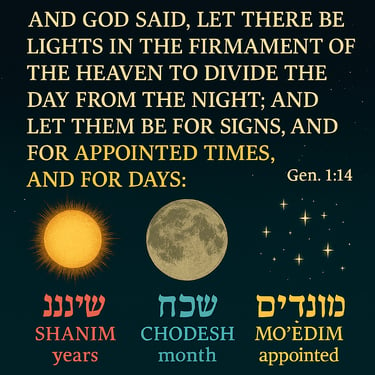

What is a year?
It is a matter of no small significance, when regarding the reckoning of time as understood by the ancients, to observe that a year—termed Shanah in the sacred tongue (שָׁנָה)—was not determined solely by the course of the moon, nor yet by the sun alone, but rather by a delicate harmony between the lunar months and the tropical solar year, that being approximately three hundred sixty-five days, five hours, forty-nine minutes, and twelve seconds. This reconciliation was not a matter of theoretical interest, but one of considerable practical consequence, for the year must needs be aligned with the seasons, and particularly with that of the barley harvest, which served as a pivotal marker.
The Passover, or Pesach (פֶּסַח), a most solemn observance, was by divine ordinance to be kept in the month of Aviv—a term which not only denotes the ripening grain, but also the spring itself, the first and most hopeful portion of the year. In order to ensure that this sacred time should not drift into impropriety, intercalculations—those subtle and necessary adjustments—were made, owing to the undeniable reality that the heavens do not always adhere to tidy precision. It is worth particular note that no one, in their observance, ever perceived two new moons within the same month—a phenomenon which would have upended the entire structure.
To prevent such disarray, the wise among them instituted what is known as the leap month, a second Adar, delicately inserted as the Twelfth month in those years that required it. Alongside this, the number of days in certain months—specifically the eighth, ninth, and thirteenth—was subject to variation. From these necessary alterations arise six distinct lengths of years, divided with elegant symmetry into two classes: three common and three embolismic. The common years consist of 353, 354, or 355 days; while the embolismic, that is, the inserted years, contain 383, 384, or 385 days.
The term embolismic, I must add, is derived from the Greek embolimos (ἐμβόλιμος), signifying that which is inserted or intercalated—a word whose elegance is matched by its utility. This system yields a cycle of nineteen years, after which the lunar reckonings resume their original correspondence. Though commonly attributed to the astronomer Meton of Athens, whose name now adorns this cycle, it is believed by many that such a method was long in use by the Sumerians, whose diligence in the study of the heavens cannot be overstated.
The present discourse shall concern itself chiefly with a span of two years, encompassing portions of the Hebrew years 3757 through 3759, which correspond to the Julian years 751 and 752 AUC. This would be 107 Metonic cycles ago. It is within this carefully chosen window that our attention shall dwell, examining how the sacred and celestial converged in the ordering of time.
The Hebrew Months
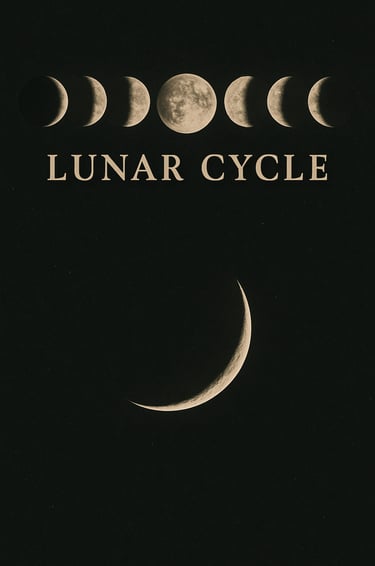

As Hebrew months consists of either 29 or 30 days. The Hebrew calendar is unlike any other, and it presents, to many Western minds, a system rather difficult to apprehend. It is both lunar and solar, governed by a rhythm of observation and calculation. Days are not named, but numbered; months are both named and numbered; and the year begins not with January, but with Nisan—also called Aviv—once the molad, or new moon, is sighted or computed. This is not speculation, but divine ordinance, first declared in Exodus 12:2 and maintained with devotion throughout the ages. In leap years, a thirteenth month, Adar I, or Adar Rishon, is inserted following the month of Shevat, extending the year to ensure Passover remains in its proper season. The necessity for this adjustment is born of astronomical reality; a lunation, after all, consists of approximately 29.53 days. The months are to be found in Ring J. Without such intercalations, the sacred festivals would drift from their appointed times. And as it was with the months, so too it must have been with the Mishmarot, those priestly courses of service, assigned in cycles of sacred duty, which appear in Ring G of this calendar. These, too, required adjustment to remain aligned with the Shabbat and the lunar cycle. The calendar thus honours both the observation and calculation of the new moon, methods which are not in conflict, but rather two instruments in faithful harmony. Opposition to the calculated method would be valid only if it yielded either no new moon in a given month or more than one, neither of which occurs. This is the heritage of the tribe of Issachar, of whom it is written in I Chronicles 12:32, that they understood the times and knew what Israel ought to do. It was not the sect of Qumran, but Issachar, whom the Torah entrusts with this sacred responsibility. Arguing that the calculated method stands in opposition to observational practice would hold validity only if it failed to produce a new moon in a given month, or if it rendered more than one new moon per month.
The Lesser Light
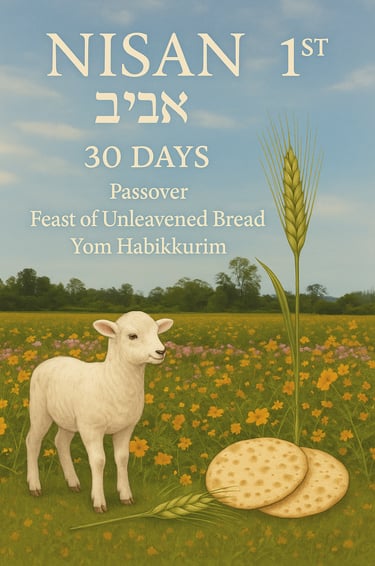

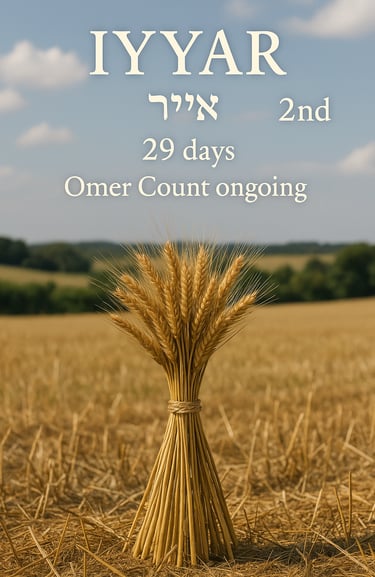


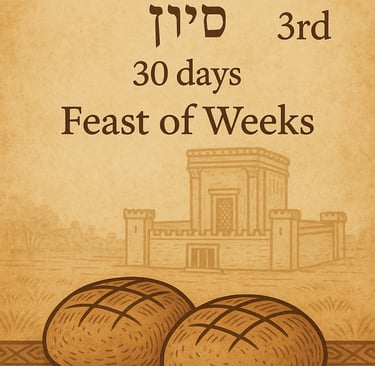
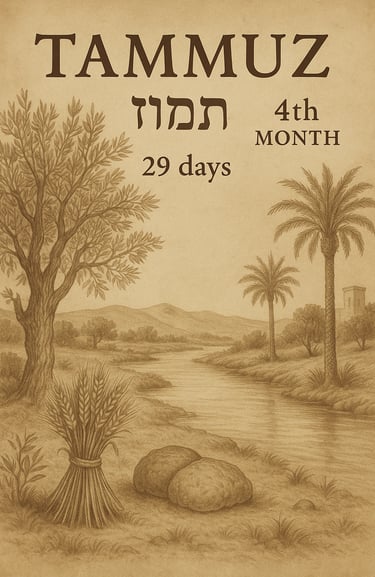

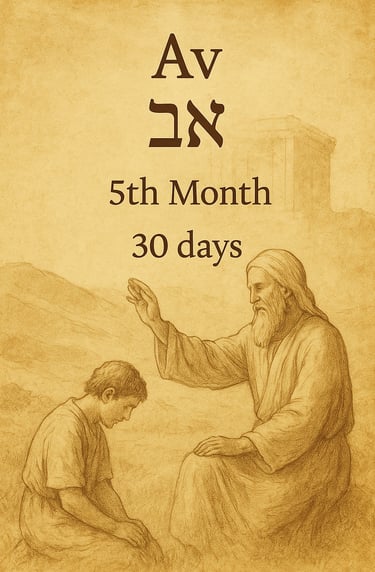

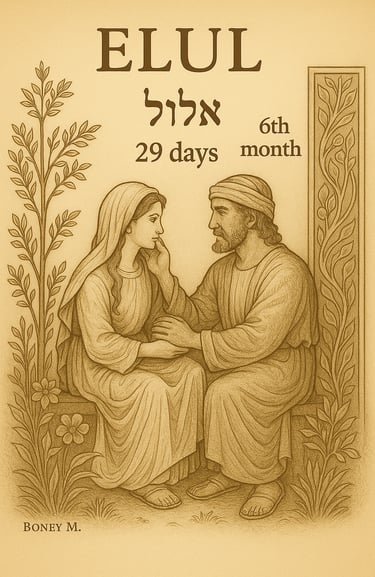

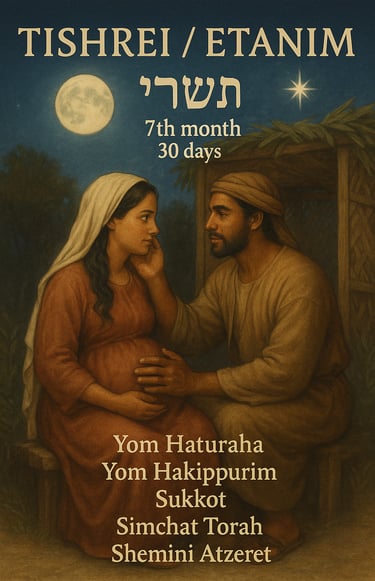



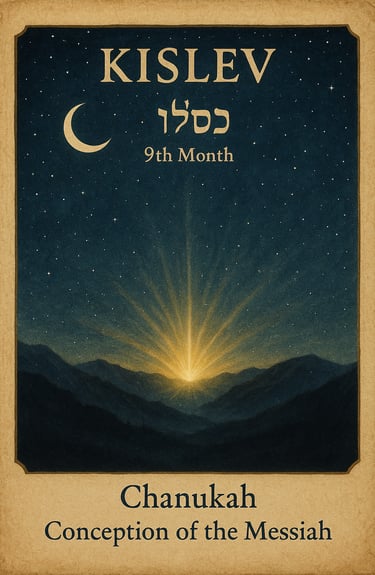

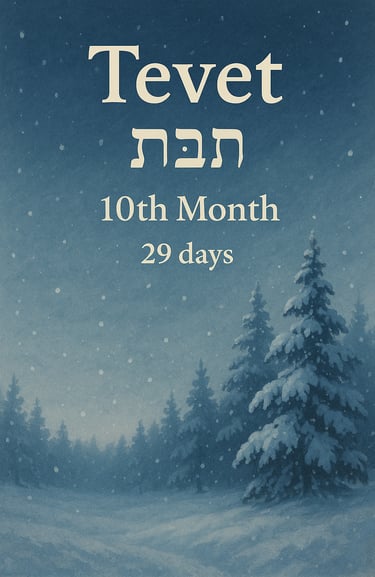

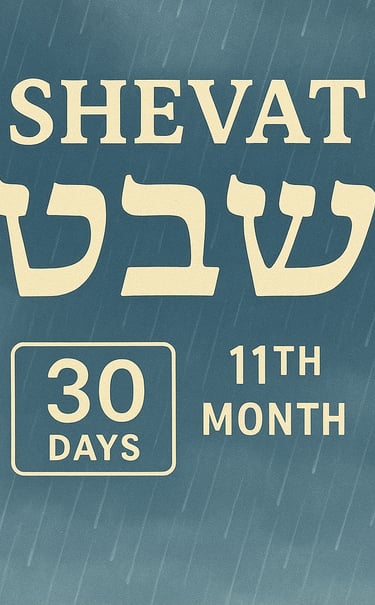

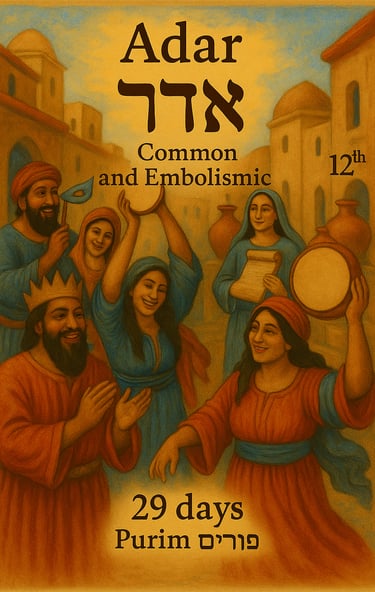


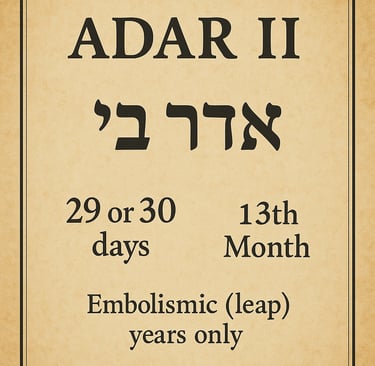
This additional month also called Adar is labeled a variety of ways by chronographers. It is inserted in two forms of either 29 days or 30 days in Embolismic years. Some times called V'Adar, Second Adar, Adar bet. It is inserted after Shevat.
The Week
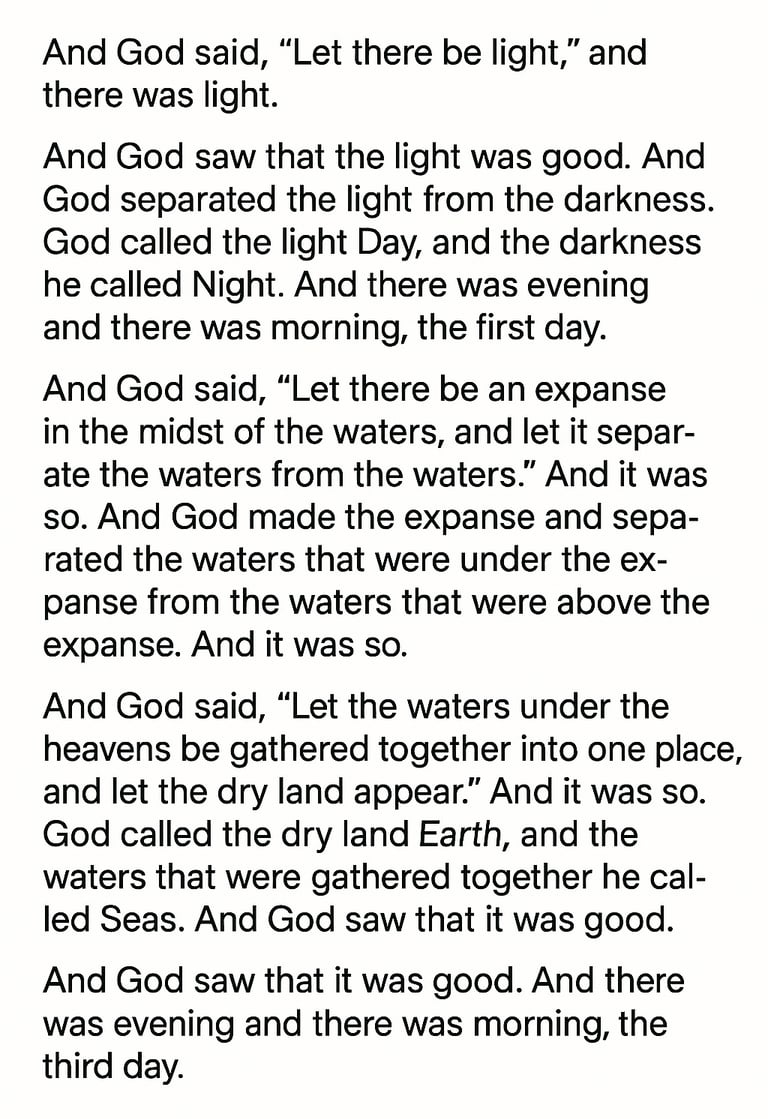

The formation of a unit of time that is a division of month is ancient and existed in many cultures. The Akkadian term "šapattu" referred to the full moon or a rest day, and it's attested in texts from the Hammurabi period (~18th century BCE), though its exact calendrical function is debated. The text of Bereshiet (Genesis) 1:3 through 2:3 are of what the LORD God of Israel pronounced.
The Day
Days of the Week
Biblical Reference. Ordinal Day (English). Hebrew Day (Hebrew Script)
Genesis 1:5 "the first day" יוֹם רִאשׁוֹן
Genesis 1:8 "the second day" יוֹם שֵׁנִי
Genesis 1:13 "the third day". יוֹם שְׁלִישִׁי
Genesis 1:19 " fourth day" יוֹם רְבִיעִי
Genesis 1:23 "the fifth day" יוֹם חֲמִישִׁי
Genesis 1:31 "the sixth day" יוֹם שִׁשִּׁי.
Genesis 2:2-3. "the seventh day" (Sabbath). יוֹם שַׁבָּת
In the sacred account found in Beresheit—that is to say, the Book of Genesis—from chapter 1, verse 3, through to chapter 2, verse 3, the days of the week are identified solely by ordinal designation. No names are bestowed upon them, save for the final day, which alone is honoured with a title: it is called Shabbat. The Scripture presents these days in the most direct and unembellished manner, each one commencing with the setting of the sun and concluding with the next. As such, the duration of each may vary. It is worthy of note that while the Greek and Latin traditions do indeed possess names for the days of the week, such nomenclature is curiously absent from their respective translations of the sacred text. English translations, too, have followed suit. The Biblical custom of employing ordinal terms has been preserved by the translators, though it must be observed with some regret that such fidelity has not extended to the realm of theology, wherein the convention appears to have been much neglected.


The Mishmarot
or
Ma'amadot
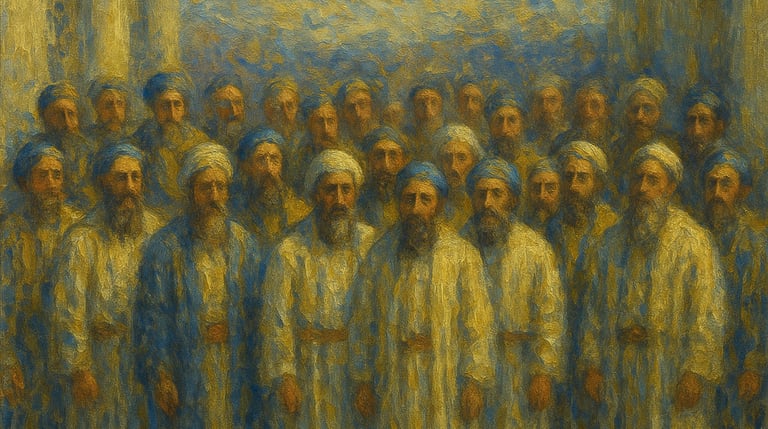

The divisions of the priesthood, arranged most judiciously into twenty-four distinct and named courses, appear in biannual rotation and are faithfully inscribed upon the left margin of the calendar, encompassed within what is designated as Ring G. These courses, or Mishmarot, recur with constancy each year, a fact well-attested by numerous references found throughout the Mishnah, which speak with singular clarity upon the matter. It is worth observing, with no small degree of interest, that in the earlier portion of Ring G, these names are rendered in the sacred tongue—Hebrew—while in the latter half they appear in transliterated form, likely for the ease of those less conversant with the original script. This careful intercalculation is by no means incidental; rather, it is an intentional safeguard, designed to forestall the sort of temporal drift that might otherwise afflict the calendar's other features, were such precautions neglected. Moreover, a point of some importance is made in the First Book of Chronicles, chapter twenty-four, verse nineteen, where a significant clarification concerning the Mishmarot is conveyed. That being, that these were their appointments in their service, to come into the house of the LORD according to their order—an arrangement that was not only established but preserved. Indeed, it is most noteworthy that this same arrangement is employed by the Evangelist Luke in the opening of his narrative, as found in chapter one, verse five. There, with a precision most admirable, he makes mention of the course of Abijah—a reference not incidental, but deliberate—serving as a chronological marker by which the attentive reader may trace the unfolding of events which follow, and which, in due time, culminate in the birth of Yeshua, now more widely known by the name Jesus. Such a detail, though it may appear modest at first glance, is in truth a linchpin of sacred chronology, weaving together the priestly order, the prophetic expectation, and the providential moment. It stands as a quiet but profound affirmation that the service of the Temple, its cycles and divisions, were not merely relics of a former age, but instruments yet employed in the grand orchestration of divine purpose. It must be observed that, just as the calendar is subject to intercalation, so too must the Mishmarot be adjusted accordingly, in order to remain in harmony with the proper reckoning of years. The practice of such alignment was not merely incidental, but thoroughly established and faithfully observed. This necessity compels the use of a system—indeed, a device—by which the periods of collective service might be so ordered as to accommodate the intercalary adjustments with both accuracy and reverence. This practice, however, was never embraced by the Greeks or the Romans, who regarded the Priesthood as possessing no particular relevance; nor was it continued by the Rabbis, in their calendar, following the dissolution of the Priesthood at the hands of those same Romans. Indeed, the failure to acknowledge that the Priesthood—and the High Priest in particular—yet retain a present connection, as but a shadow of the Heavenly reality, is a matter quite lost upon the traditions of the West. The sacerdotalism of the Catholic Church, with its elaborate liturgical structure, as well as the Rabbinic Machzor for Yom Kippur, serve rather to obscure than to affirm the enduring significance of the Biblical Priesthood.
מִשְׁמָרוֹת
Calendar
Faith
Nature
contact@tishrei15.com
+1 941-289-4930
© 2025. All rights reserved.
Write your text here...


